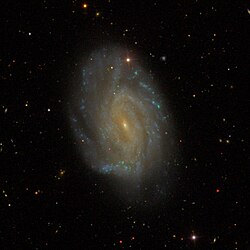| NGC 3726 | |
|---|---|
 NGC 3726 imaged by the Sloan Digital Sky Survey | |
| Observation data (J2000 epoch) | |
| Constellation | Ursa Major |
| Right ascension | 11h 33m 21.1s [1] |
| Declination | 47° 01′ 45″ [1] |
| Redshift | 866 ± 1 km/s [1] |
| Distance | 46.6 ± 11.2 Mly (14.3 ± 3.4 Mpc) [1] |
| Apparent magnitude (V) | 10.2 |
| Characteristics | |
| Type | SAB(r)c [1] |
| Apparent size (V) | 6.2′ × 4.3′ [1] |
| Other designations | |
| UGC 6537, MCG +08-21-051, PGC 35676 [1] | |
NGC 3726 is a barred spiral galaxy located in the constellation Ursa Major. It is located at a distance of circa 45 million light years from Earth, which, given its apparent dimensions, means that NGC 3726 is about 85,000 light years across. It was discovered by German-British astronomer William Herschel on February 5, 1788. [2]
